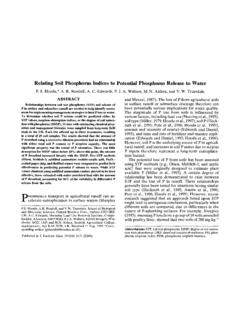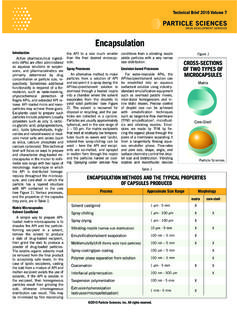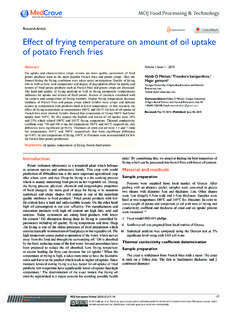Transcription of Long-term phosphorus effects on evolving …
1 journal of colloid and interface Science 287 (2005) 552 phosphorus effects on evolving physicochemical properties ofiron and aluminum hydroxidesKonstantinos C. Makrisa, , Willie G. Harrisb, George A. O Connorb, Hassan El-ShallcaEnvironmental Geochemistry Laboratory, Center for Water Research, University of Texas, San Antonio, 6900 North Loop 1604,San Antonio, TX 78249-0663, USAbDepartment of Soil and Water Science, University of Florida, Gainesville, FL 32611, USAcDepartment of Materials Science & Engineering and Particle Science and Technology Center, 205C Particle Sci. & Tech., University of Florida,Gainesville, FL 32611, USAR eceived 6 January 2005; accepted 8 February 2005 Available online 3 March 2005 AbstractIron (Fe) and aluminum (Al) hydroxides are highly reactive components in environmental processes, such as contaminant fate and trans-port.
2 phosphorus (P) sorption by these components can decrease environmental problems associated with excess accumulation of P in Long-term stability of P sorbed by Fe/Al hydroxides is of major concern. Synthetic Fe and Al hydroxides coprecipitated with P (1:1metal:P molar ratio) were incubated at 70 C for 24 months to simulate natural Long-term weathering processes that could influence thestability of sorbed P. Heat incubation (70 C) of the untreated (no P) Al hydroxides resulted in drastic decreases (within the first month ofincubation) in oxalate Al extractability, specific surface area (SSA), and micropore volume with time. These changes were consistent withthe formation of pseudoboehmite. Untreated Fe hydroxides showed no formation of crystalline components following heating (70 C) for24 months.
3 Much smaller changes in oxalate-Al, P extractability, and SSA values were observed in the P-treated Al particles when comparedwith the untreated. phosphorus treatment of both Fe and Al hydroxides stabilized the particle surfaces and prevented structural arrangementstoward a long-range ordered phase. Slight reduction in SSA of the P-treated particles was related to dehydration phenomena during heatingat 70 C. Monitoring of physicochemical properties of the solids after heating at 70 C for 2 years showed that sorbed P may be stable inthe Long-term . Understanding long term physicochemical properties may help engineers to optimize the Fe/Al hydroxides performance inseveral environmental/industrial applications.
4 2005 Elsevier Inc. All rights :Iron and Al hydroxides; Stability; Heat incubations; Microporosity; Specific surface area1. IntroductionIron (Fe) and aluminum (Al) hydroxides are ubiquitousin soils and play a key role in contaminant transport andreactivity. Iron and Al hydroxides are usually small in size(<2 m), vary in crystallinity, and are often characterized bylarge specific surface areas (SSAs). In soils, Fe and Al hy-Abbreviations:SSA, specific surface area; P, phosphorus ; Fe/Al hy-droxides, iron/aluminum hydroxides.*Corresponding author. Fax: +1 210 458 Makris).droxides are the product of primary and secondary mineralweathering, and exist both as mineral coatings and discretephases.
5 Thermodynamic stabilities of Fe and Al hydroxidesin soils regulate the fate and availability of macronutrients,like phosphorus (P). Iron or Al hydroxides may greatly in-crease a sandy soil s P sorption capacity, reducing off-siteP losses that have been correlated with excess P amounts inwater bodies[1].Iron and Al hydroxides find use in environmental aswell as industrial applications. phosphorus -treated Al andFe hydroxides have attracted much attention as catalysts, orion exchangers for heavy metals[2]. Aluminum phosphates0021-9797/$ see front matter 2005 Elsevier Inc. All rights Makris et al. / journal of colloid and interface Science 287 (2005) 552 560553have also been used to remove heavy metals (Co, Ni, and Cu)from aqueous solutions[3].
6 Amorphous Al phosphates (1:1P:Al molar ratios) are used as adjuvants in licensed humanvaccines as the stimulant for the immune response[4].Amorphous Fe and Al hydroxides can be metastable,transforming with time to thermodynamically stable general rule is that crystal growth increases with increas-ing pH and temperature[5].AtpH< , gibbsite [Al(OH)3]readily forms because conversion rates from boehmite[AlO(OH)] to bayerite [Al(OH)3] to gibbsite are fast[5].Amorphous Fe hydroxides transform to more crystallinephases either by dissolution/reprecipitation (to goethite, -FeO(OH)), or by structural rearrangements (to hematite,Fe2O3)[6]. Goethite formation is usually favored under con-ditions of dissolution/reprecipitation phenomena.
7 Hematiteformation is favored by dehydration at pH values wherethe solid has the lowest solubility and the greatest poten-tial for coagulation/aggregation[7]. In low water activity ordry systems, transformations occur, but at lower rates, sinceion mobility is restricted. After years, air-dried two-lineferrihydrite transformed to hematite at room temperature[6].Internally adsorbed water facilitated the conversion process,even at low water content (100 to 150 g kg 1water). How-ever, in dry systems, hematite will form in<20 years astemperatures increase to 300 C[6]. Hematite formationis more sensitive to temperature changes than goethite for-mation[8].Amorphous Fe and Al hydroxides usually contain im-purities, such as inorganic and organic ions that can in-fluence particle stability.
8 Specific adsorption of inorganicanions, such as phosphates, largely retarded the transfor-mation of ferrihydrite to a more crystalline atomic arrange-ment[7]. Phosphate was the most important inorganic lig-and in inhibiting crystallization of Al hydroxides followedby silicate>sulfate>chloride>nitrate>perchl orate[9].Crystallization of ferrihydrite, as evidenced by oxalateextractions, proceeded normally at arsenate loads up g kg 1after 125-day incubation at 40 C, and arsen-ate was stabilized into the goethite/hematite structure[10].Greater arsenate loads retarded ferrihydrite crystallization[10]. In the absence of phosphate, ferrihydrite was trans-formed to hematite and goethite mixtures when incubatedfor 2 years at 25 C, or 2 months at 50 C[11].
9 When Pwas added, ferrihydrite transformation was largely retarded,and at P/Fe ratios> , the oxalate-extractable Fe/totalFe ratio was 1, suggesting no formation of a crystallinephase[11]. Similarly, dissolution rates of Fe hydroxidesin the presence of sorbed phosphate were significantly re-duced[12].Contrasting theories deal with the stability of sorbed ionsby Fe and Al hydroxides. The classic theory of aging sup-ports the idea of structural reorganization of an amorphoussolid phase by ion incorporation into the solid, forming a solid solution [13]. Solubility of long-range ordered ox-ides is usually orders-of-magnitude less than that of theamorphous solid and the vulnerability of these oxides to mi-crobially induced Fe reduction is significantly less[14].
10 Ionpartitioning is envisioned to be irreversible, unless dissolu-tion of the host mineral aging may occur by heat input, which increasesthe translational energy of atoms, and thus, transformationrates toward a lower free energy system. Heat incubationof amorphous metal hydroxides could hasten transformationreaction rates and heat treatment has been used as an exper-imental technique to study Long-term structural and physicalchanges of solids[15,16]. Aging (200 days) and subsequentincubation at 70 C for 2 months of Cd, Cu, and Zn coprecip-itates with amorphous Fe hydroxides resulted in decreasedCd and Zn solubility[15]. Despite Cu movement toward thesurface with increasing aging time (up to 2 years at 23 C),decreased Cu solubility resulted from the coprecipitationof Cu with alumina[17].






